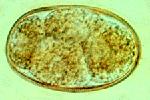Difference between revisions of "Category:Ancylostomatoidea"
| Line 14: | Line 14: | ||
As with all hookworms, the L3 can penetrate the skin. A protective immunity develops, and so enteric disease is largely confined to pups. Some dogs develop a hypersensitivity, leading to a pedal dermatitis which can affect all ages. | As with all hookworms, the L3 can penetrate the skin. A protective immunity develops, and so enteric disease is largely confined to pups. Some dogs develop a hypersensitivity, leading to a pedal dermatitis which can affect all ages. | ||
| + | |||
| + | <ncl style=compact maxdepth=5 headings=bullet headstart=2 showcats=1 showarts=1>Category:{{PAGENAME}}</ncl> | ||
| + | |||
[[Category:Bursate_Nematodes]] | [[Category:Bursate_Nematodes]] | ||
Revision as of 21:19, 28 April 2010
General Appearance
- Like the Strongyloidea, except the head is bent dorsally
- All have a large buccal cavity with teeth and/or cutting plates
- Some also have teeth and/or cutting plates around the mouth
General Life-Cycle
- Like that of the Strongyloidea, but infection can be by ingestion and/or skin penetration
- Ancylostoma in myositis
- Ancylostoma and Uncinaria in skin infections
The hookworms are 1-2cm long bursate nematodes. They are easily identified under the microscope, as they have a large buccal cavity with teeth, and the mouth points dorsally. Some have teeth around the rim of the mouth which can be used for identification, and which are used to embed the head deeply into the mucosa of the small intestine. The life-cycle is typical for the superfamily.
As with all hookworms, the L3 can penetrate the skin. A protective immunity develops, and so enteric disease is largely confined to pups. Some dogs develop a hypersensitivity, leading to a pedal dermatitis which can affect all ages.
<ncl style=compact maxdepth=5 headings=bullet headstart=2 showcats=1 showarts=1>Category:Ancylostomatoidea</ncl>
Pages in category "Ancylostomatoidea"
The following 5 pages are in this category, out of 5 total.
